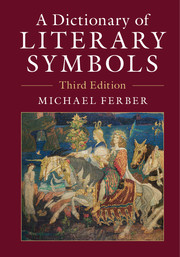General
Biedermann, Hans. Dictionary of Symbolism: Cultural Icons and the Meanings Behind Them. Trans. Hulbert, James. New York: Facts on File, 1992.
Butzer, Günter, and Jacob, Joachim, ed. Metzler Lexikon literarischer Symbole. Stuttgart: Verlag J. B. Metzler, 2008.
Chevalier, Jean and Gheerbrant, Alain. The Penguin Dictionary of Symbols. Trans. Buchanan-Brown, John. London: Penguin, 1996. (French edn. 1969.)
Curtius, Ernst Robert. European Literature and the Latin Middle Ages. Trans. Trask, Willard. New York: Pantheon (Bollingen), 1953.
Daemmrich, Horst S. and Daemmrich, Ingrid G.. Themes and Motifs in Western Literature: a Handbook. Tübingen: Francke Verlag, 1987.
Daemmrich, Horst S. and Daemmrich, Ingrid G.. Themen und Motive in der Literatur: ein Handbuch. Second, enlarged edition. Tübingen: Francke Verlag, 1995.
Ferguson, George. Signs and Symbols in Christian Art. New York: Oxford University Press, 1954.
Frye, Northrop. Anatomy of Criticism. Princeton University Press, 1957.
Ferguson, George. The Great Code: the Bible and Literature. New York: Harcourt Brace, 1981.
Hamilton, A. C., ed. The Spenser Encyclopedia. University of Toronto Press, 1990.
Lakoff, George and Turner, Mark. More than Cool Reason: a Field Guide to Poetic Metaphor. University of Chicago Press, 1989.
Onians, R. B. The Origins of European Thought. Cambridge University Press, 1951.
Otto, A. Die Sprichwörter und sprichwörtlichen Redensarten der Römer. Leipzig, 1890; rpt. Hildesheim: Olms, 1965.
Pöschl, Viktor, ed. Bibliographie zur Antiken Bildersprache. Heidelberg: C. Winter, 1964.
Roberts, Helene E., ed. Encyclopedia of Comparative Iconography. Chicago, Ill. and London: Fitzroy Dearborn, 1998.
Seigneuret, Jean-Charles, ed. Dictionary of Literary Themes and Motifs. 2 vols. New York: Greenwood Press, 1988.
Smith, Eric. Dictionary of Classical Reference in English Poetry. Cambridge: D. S. Brewer, 1984.
Stevenson, Burton. The Home Book of Proverbs, Maxims and Familiar Phrases. New York: Macmillan, 1948.
Whittick, Arnold. Symbols, Signs, and Their Meanings. London: Leonard Hill, 1960.
Ziolkowski, Theodore. Varieties of Literary Thematics. Princeton University Press, 1983. See the appendix called “A Practical Guide to Literary Thematics.”



